Digital Humanities for the Heritage of Political Ideas in Medieval Bologna
Abstract
1. Introduction
2. Urban Spaces and Associationism: The Political Role of the Neighbourhood Societies
3. Materials and Methods
3.1. The Evolution of Digital Historical Research: Bologna’s Innovative Approach
3.2. Digital Humanities and Archival Historical Sources
- Acquisition of written sources through digital scanning;
- Analysis;
- Dissemination.
3.3. Visual Technologies and Archival Historical Sources: Methodological Approach
3.4. The Web Visualisation of Statutory Provisions (The Statutes of the Stripes of Saragozza)
3.5. Visualising Medieval Urban Space
- The parish of S. Caterina di Saragozza;
- The parish of S. Maria delle Muratelle;
- The parish of S. Cristoforo di Saragozza;
- The trivium (junction of three streets) of S. Maria delle Muratelle.
- The perimeter of the second ring of walls (Torresotti walls): Derived from a study on the 13-century survey of urban spaces [43], this layer not only shows the layout of the city walls but also shows the other elements related to the walls, which made up the defensive circuit:
- ○
- The street inside the walls;
- ○
- The walls;
- ○
- The moat outside the walls;
- ○
- The street outside the walls.
- The gates, or Serragli, of the second ring of walls (the positions of these elements are known, the demolition of most of them took place even centuries after the Torresotti walls were landed, and four of them are still present today);
- The medieval parishes, or cappelle. The identification and positioning of the cappelle is also the result of an in-depth study of the medieval Bolognese estimi [44];
- The street layout, limited to the extension inside the Torresotti walls and devoid of the modifications that have occurred since the modern age;

4. Results
5. Conclusions
Author Contributions
Funding
Data Availability Statement
Conflicts of Interest
References
- Weber, M. Economy and Society: An Outline of Interpretive Sociology; University of California Press: Oakland, CA, USA, 1978; ISBN 978-0-520-03500-3. [Google Scholar]
- Farr, J.R. Artisans in Europe, 1300–1914; Cambridge University Press: Cambridge, UK, 2000; ISBN 978-0-521-42934-4. [Google Scholar]
- van Steensel, A. Guilds and Politics in Medieval Urban Europe. Towards a Comparative Institutional Analysis. In Craftsmen and Guilds in the Medieval and Early Modern Periods; Franz Steiner Verlag: Stuttgart, Germany, 2016; pp. 37–56. [Google Scholar]
- Keene, D.J. English h Urban Guilds, c.900-1300: The Purposes and Politics of Association. In Guilds and association in Europe, 900-1900; Institute of Historical Research: London, UK, 2006; pp. 3–26. [Google Scholar]
- Laumonier, L. Guilds and Urban Governance: Montpellier, c. 1350–1530. J. Mediev. Hist. 2025, 51, 368–388. [Google Scholar] [CrossRef]
- Blanshei, S.R. Politics and Justice in Late Medieval Bologna; Brill Academic Publishing: Leiden, The Netherlands, 2010. [Google Scholar]
- DALME. Available online: https://dalme.org/ (accessed on 23 May 2025).
- Tamba, G. Consigli Elettorali Degli Ufficiali Del Comune Bolognese Alla Fine Del Secolo XIII. Rassegna Degli Arch. Stato 1982, 42, 34–95. [Google Scholar]
- Münster, S.; Maiwald, F.; Bruschke, J.; Kröber, C.; Sun, Y.; Dworak, D.; Komorowicz, D.; Munir, I.; Beck, C.; Münster, D.L. A Digital 4D Information System on the World Scale: Research Challenges, Approaches, and Preliminary Results. Appl. Sci. 2024, 14, 1992. [Google Scholar] [CrossRef]
- Apollonio, F.I.; Fallavollita, F.; Foschi, R.; Smurra, R. Multi-Feature Uncertainty Analysis for Urban-Scale Hypothetical 3D Reconstructions: Piazza Delle Erbe Case Study. Heritage 2024, 7, 476–498. [Google Scholar] [CrossRef]
- Baik, A. A Comprehensive Heritage BIM Methodology for Digital Modelling and Conservation of Built Heritage: Application to Ghiqa Historical Market, Saudi Arabia. Remote Sens. 2024, 16, 2833. [Google Scholar] [CrossRef]
- Spreafico, A.; Chiabrando, F. 3D WebGIS for Ephemeral Architecture Documentation and Studies in the Humanities. Heritage 2024, 7, 913–947. [Google Scholar] [CrossRef]
- Long, L.; Gan, Z.; Liu, Z.; Zhao, B.; Li, Q. MSD-Det: Masonry Structures Damage Detection Dataset for Preventive Conservation of Heritage. J. Cult. Herit. 2025, 73, 358–370. [Google Scholar] [CrossRef]
- Calin, M.; Damian, G.; Popescu, T.; Manea, R.; Erghelegiu, B.; Salagean, T. 3D Modeling for Digital Preservation of Romanian Heritage Monuments. Agric. Agric. Sci. Procedia 2015, 6, 421–428. [Google Scholar] [CrossRef][Green Version]
- Li, Q.; Yang, G.; Gao, C.; Huang, Y.; Zhang, J.; Huang, D.; Zhao, B.; Chen, X.; Chen, B.M. Single Drone-Based 3D Reconstruction Approach to Improve Public Engagement in Conservation of Heritage Buildings: A Case of Hakka Tulou. J. Build. Eng. 2024, 87, 108954. [Google Scholar] [CrossRef]
- Smith, M.; Walford, N.S.; Jimenez-Bescos, C. Using 3D Modelling and Game Engine Technologies for Interactive Exploration of Cultural Heritage: An Evaluation of Four Game Engines in Relation to Roman Archaeological Heritage. Digit. Appl. Archaeol. Cult. Herit. 2019, 14, e00113. [Google Scholar] [CrossRef]
- Nishanbaev, I. A Web Repository for Geo-Located 3D Digital Cultural Heritage Models. Digit. Appl. Archaeol. Cult. Herit. 2020, 16, e00139. [Google Scholar] [CrossRef]
- Cappellotto, A. From Codex to Apps: The Medieval Manuscript in the Age of Its Digital Reproduction. Um. Digit. 2020, 4, 1–18. [Google Scholar] [CrossRef]
- Cappellotto, A. Digital Scholarly Editing and Text Reconstruction: Theoretical Perspectives and Practical Approaches. In Digital Philology: New Thoughts on Old Questions; Libreria Universitaria: Limena, Italy, 2018; pp. 77–98. ISBN 978-88-6292-982-0. [Google Scholar]
- Jaillant, L.; Rees, A. Applying AI to Digital Archives: Trust, Collaboration and Shared Professional Ethics. Digit. Scholarsh. Humanit. 2023, 38, 571–585. [Google Scholar] [CrossRef]
- Shillingsburg, P. Development Principles for Virtual Archives and Editions. Cent. Textual Stud. Digit. Humanit. Publ. 2013, 11, 2–13. [Google Scholar]
- Cammarosano, P. Italia Medievale: Struttura e Geografia Delle Fonti Scritte; La Nuova Italia Scientifica: Rome, Italy, 1991. [Google Scholar]
- Fasoli, G. Le Compagnie Delle Armi a Bologna. L’Archiginnasio 1933, XXVIII, 158–183; 323–340. [Google Scholar]
- Agamben, G. Il Sacramento del Linguaggio: Archeologia del Giuramento (Homo sacer 2, 3); GLF Editori Laterza: Rome, Italy, 2008; ISBN 978-88-420-8781-6. [Google Scholar]
- Gaudenzi, A. Statuti Delle Società Del Popolo Di Bologna; Istituto Storico Italiano: Rome, Italy, 1889; Volume 1, ISBN 1-390-68002-9. [Google Scholar]
- Bocchi, F.; Elena, B.; Manuela, G.; Rosa, S.; Fernando, L. The 4D Virtual Museum of the City of Bologna, Italy. In Proceedings of the ACM SIGGRAPH 99 Conference Abstracts and Applications, Los Angeles, CA, USA, 8–13 August 1999; Association for Computing Machinery: New York, NY, USA; 1999; pp. 8–11. [Google Scholar]
- Bocchi, F. The City in Four Dimensions: The Nu.M.E. Project. J. Digit. Inf. Manag. 2004, 2, 161–163. [Google Scholar]
- Progetti. Available online: https://centri.unibo.it/fasoli-storia-citta/it/progetti (accessed on 11 June 2025).
- Digitised Manuscripts. Available online: https://www.bl.uk/research/digitised-manuscripts/ (accessed on 23 May 2025).
- Digital Collections. Available online: https://www.bsb-muenchen.de/en/competence-centers-and-state-wide-services/competence-centers/manuscript-center/digital-collections/ (accessed on 23 May 2025).
- DigiVatLib. Available online: https://digi.vatlib.it/ (accessed on 23 May 2025).
- Munich Digitization Center (MDZ)—Homepage. Available online: https://www.digitale-sammlungen.de/en (accessed on 23 May 2025).
- IIIF Community Calendar (Eastern Time). Available online: https://calendar.google.com/calendar/u/0/embed?title=IIIF+Community+Calendar+(Eastern+Time)&showPrint=0&height=600&wkst=1&bgcolor=%23ffffff&src=1hnm5h86n94ore0vnoo188ter8@group.calendar.google.com&color=%23865A5A&ctz=America/New_York (accessed on 23 May 2025).
- Archivi Digitalizzati. Available online: https://archiviodistatofirenze.cultura.gov.it/asfi/archivi-digitalizzati (accessed on 23 May 2025).
- Archivio Centrale Dello Stato—Il Portale Delle Collezioni Digitalizzate. Available online: https://tecadigitaleacs.cultura.gov.it/ (accessed on 23 May 2025).
- Stefani, C.D.; Smither, R.; Campagnolo, A. The Great Parchment Book; London Metropolitan Archives: London, UK, 2013. [Google Scholar]
- Pal, K.; Terras, M.; Weyrich, T. 3D Reconstruction for Damaged Documents: Imaging of the Great Parchment Book. In Proceedings of the 2nd International Workshop on Historical Document Imaging and Processing, Washington DC, USA, 24 August 2013; ACM: New York, NY, USA, 2013; pp. 14–21. [Google Scholar]
- Avery, N.; Campagnolo, A.; De Stefani, C.; Pal, K.; Payne, M.; Smith, P.; Smither, R.; Stewart, E.; Stewart, P.; Stewart, A.; et al. Great Parchment Book Project Journal of Digital Humanities. J. Digit. Humanit. 2014, 3, 83–86. [Google Scholar]
- Stefani, C.D.; Smith, P. The Great Parchment Book Project. In Book Conservation and Digitization: The Challenges of Dialogue and Collaboration; Campagnolo, A., Ed.; Amsterdam University Press: Amsterdam, The Netherlands, 2020; pp. 145–156. ISBN 978-1-64189-054-0. [Google Scholar]
- Glycerine. Available online: https://glycerine.io/ (accessed on 23 May 2025).
- Home—Comune Di Bologna. Available online: https://opendata.comune.bologna.it/pages/home/ (accessed on 23 May 2025).
- Smurra, R. Spatial Order and City Authorities in Thirteenth-Century Bologna. In Protagonists of Urban Order from the Middle Ages to the Present. Actions. Ideas, Concepts; Amsterdam University Press: Amsterdam, The Netherlands, 2025; pp. 105–114. ISBN 978-90-485-5951-0. [Google Scholar]
- Lugli, F. Liber Terminorum: Ricostruzione Del Tracciato Della Cerchia Dei Torresotti. In Il Duecento; Grafis: Bologna, Italy, 1995; Volume 2, pp. 106–114. [Google Scholar]
- Smurra, R. Città, Cittadini e Imposta Diretta a Bologna Alla Fine Del Duecento: Ricerche Preliminari; CLUEB: Bologna, Italy, 2007; ISBN 978-88-491-2974-8. [Google Scholar]
- Orlandi, M. La Ricostruzione 3D Di Bologna Nel XVI Secolo: La Mappa Vaticana. In La Storia Della Città per il Museo Virtuale di Bologna—Un Decennio di Ricerche nel Dottorato di Storia e Informatica; Bononia University Press: Bologna, Italy, 2010; pp. 233–246. [Google Scholar]
- Li, Q.; Yang, G.; Bian, C.; Long, L.; Wang, X.; Gao, C.; Wong, C.L.; Huang, Y.; Zhao, B.; Chen, X.; et al. Autonomous Design Framework for Deploying Building Integrated Photovoltaics. Appl. Energy 2025, 377, 124760. [Google Scholar] [CrossRef]
- Accesso Di Accesso—ArcGIS Online. Available online: https://www.arcgis.com/index.html (accessed on 23 May 2025).
- Smurra, R.; Bocchi, F. Medieval Bologna. In Oxford Bibliographies in Medieval Studies; Oxford University Press: New York, NY, USA, 2022; pp. 1–30. [Google Scholar]
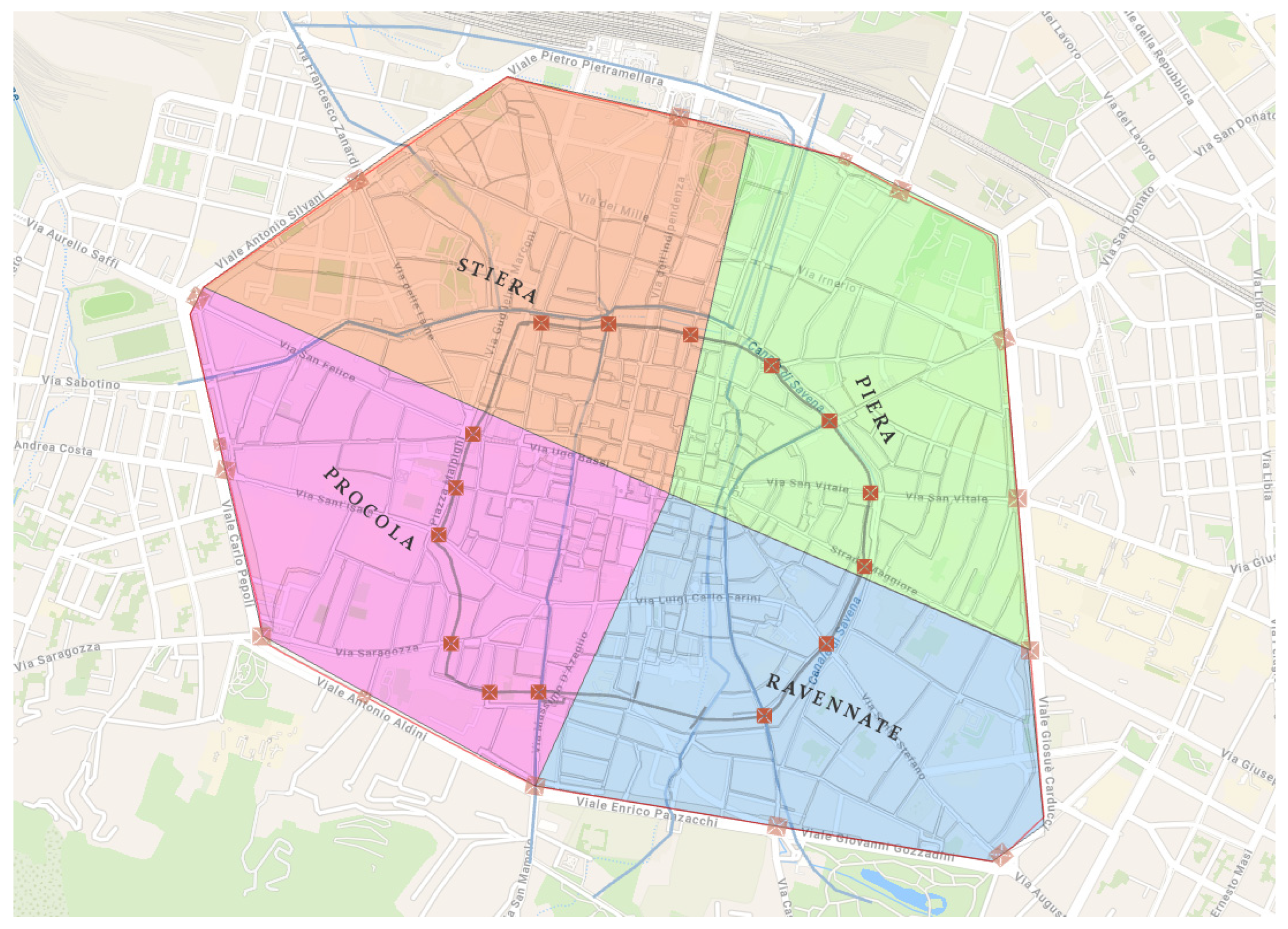
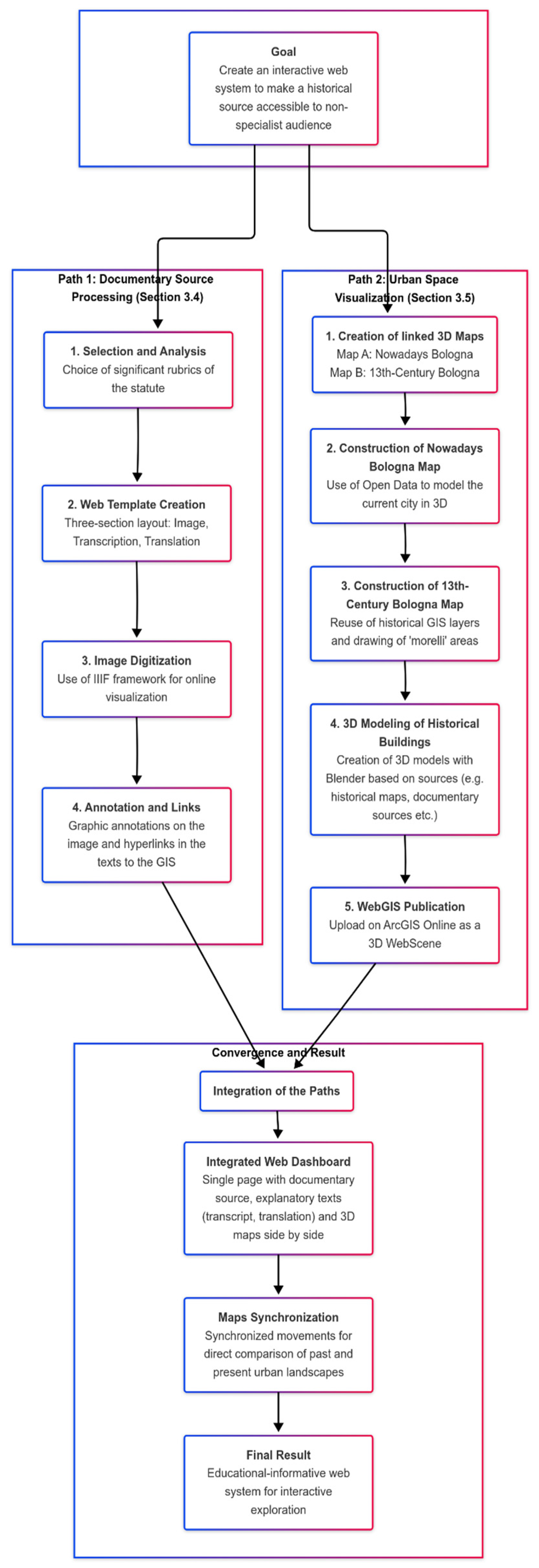
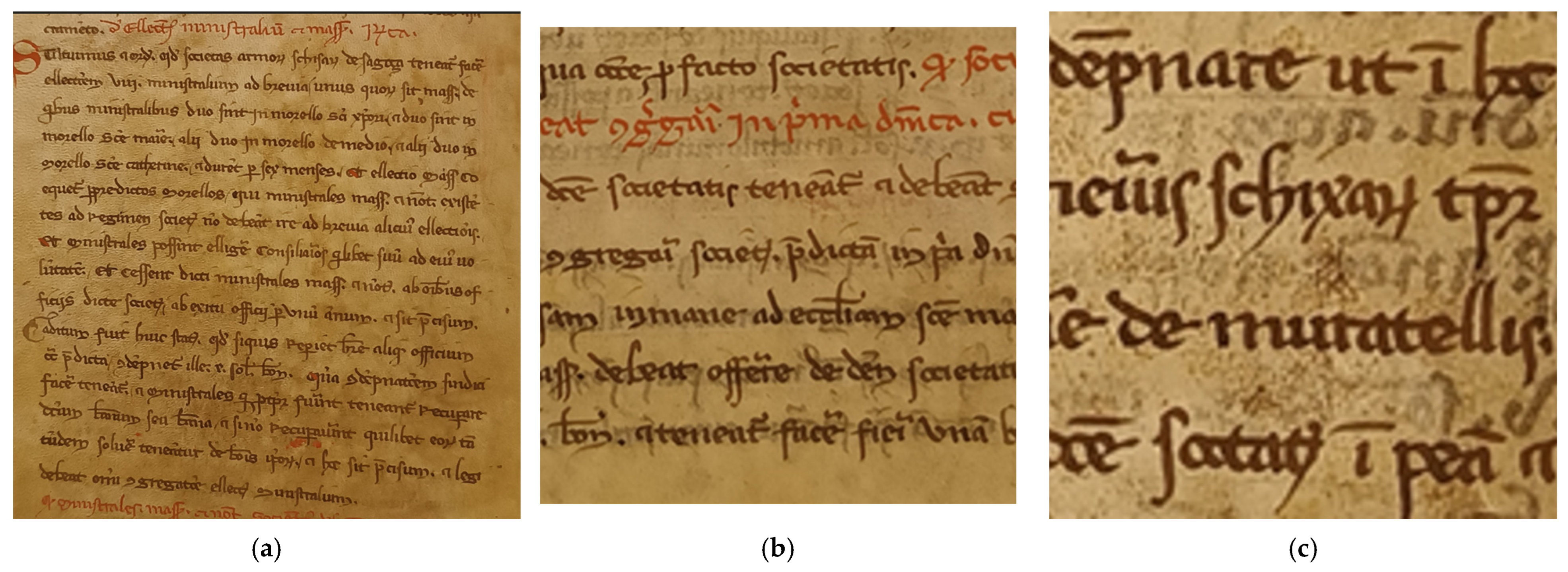
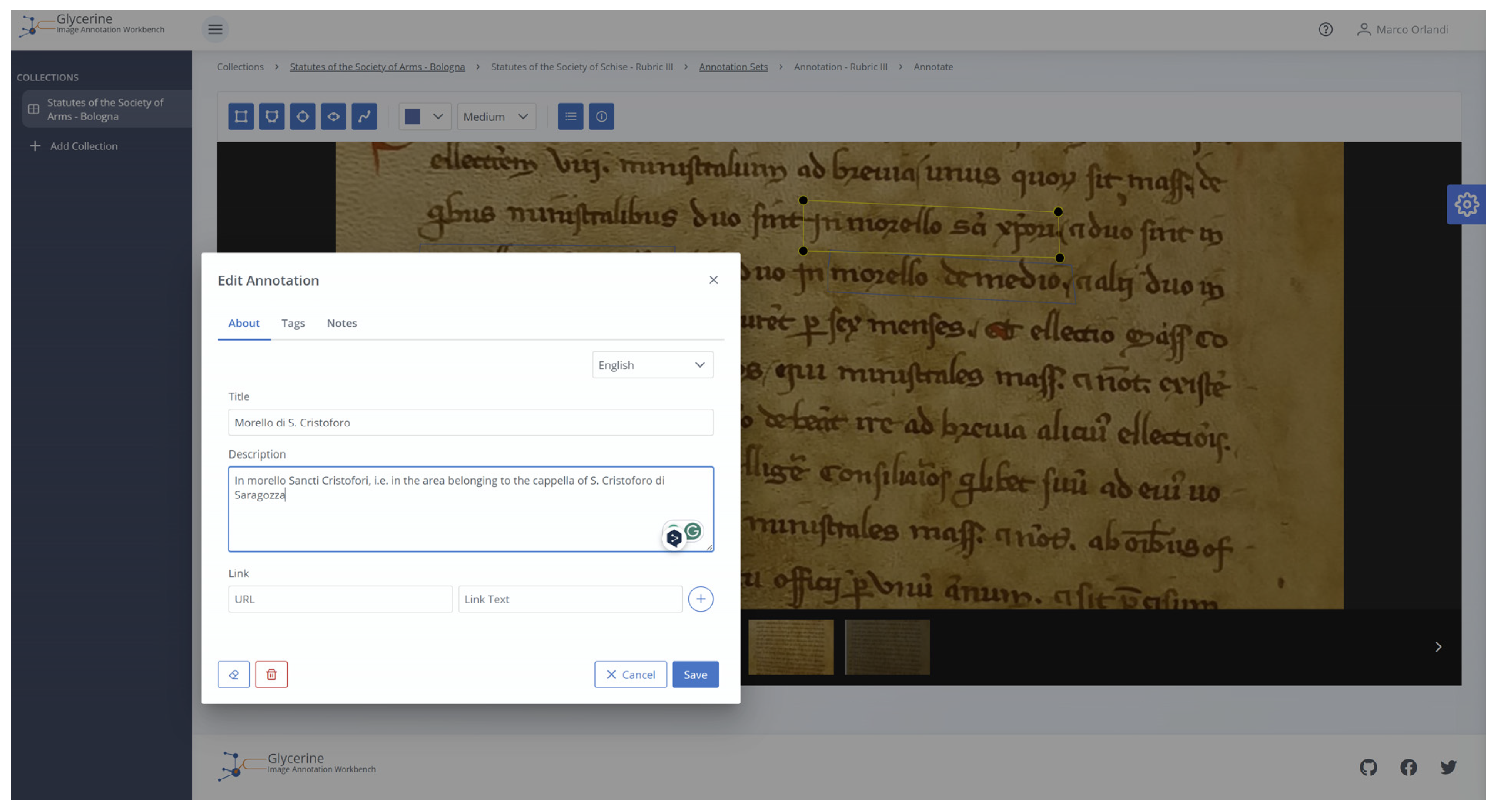
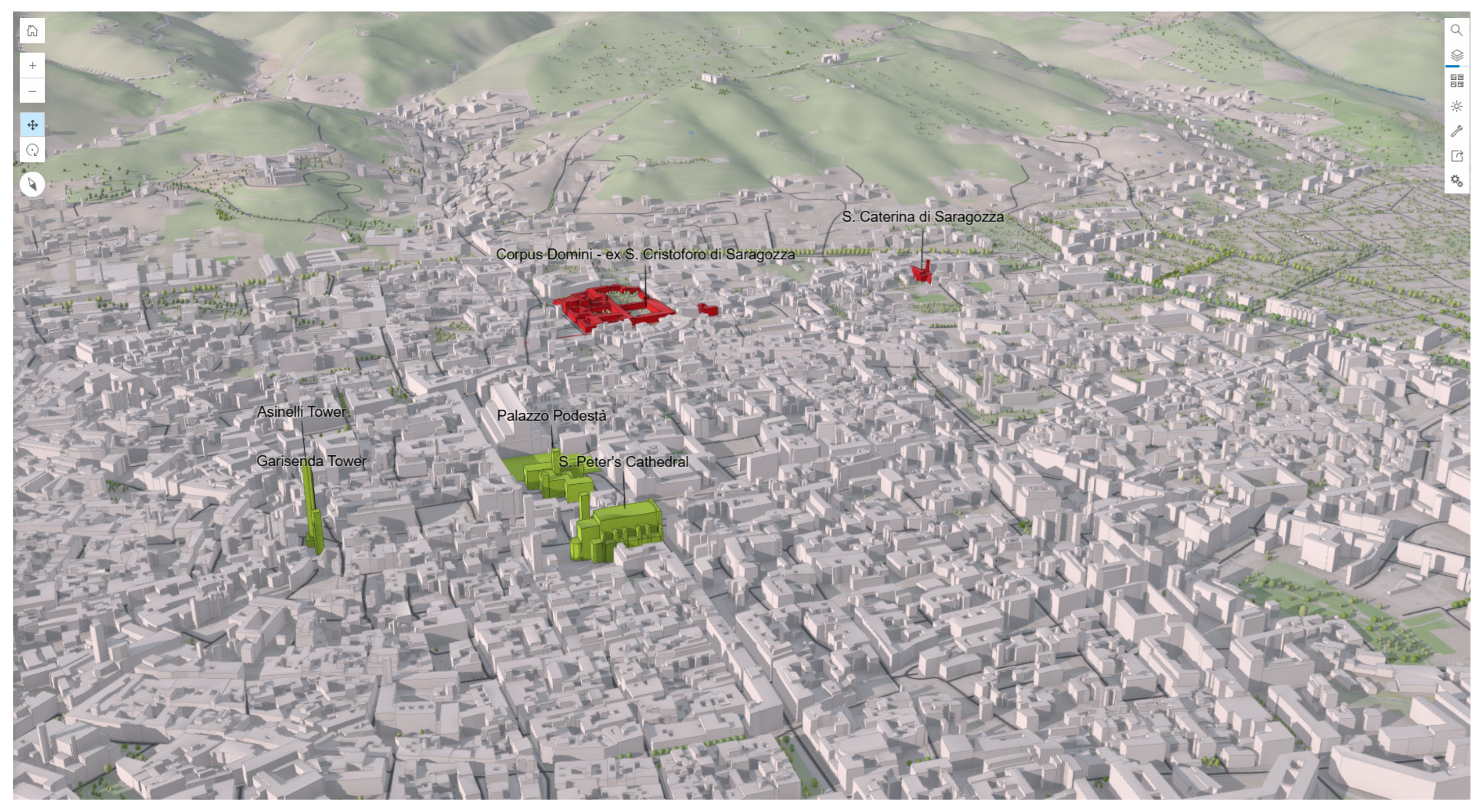
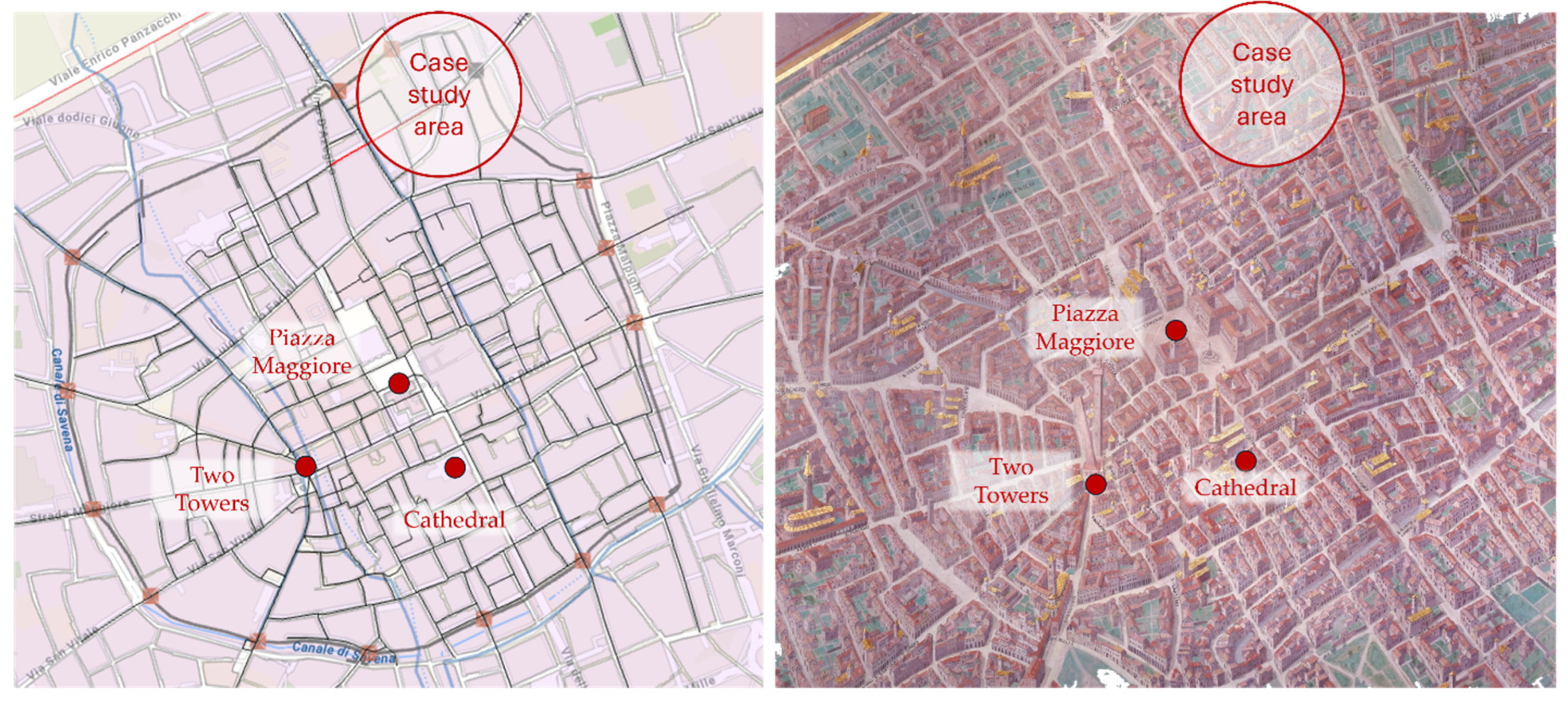

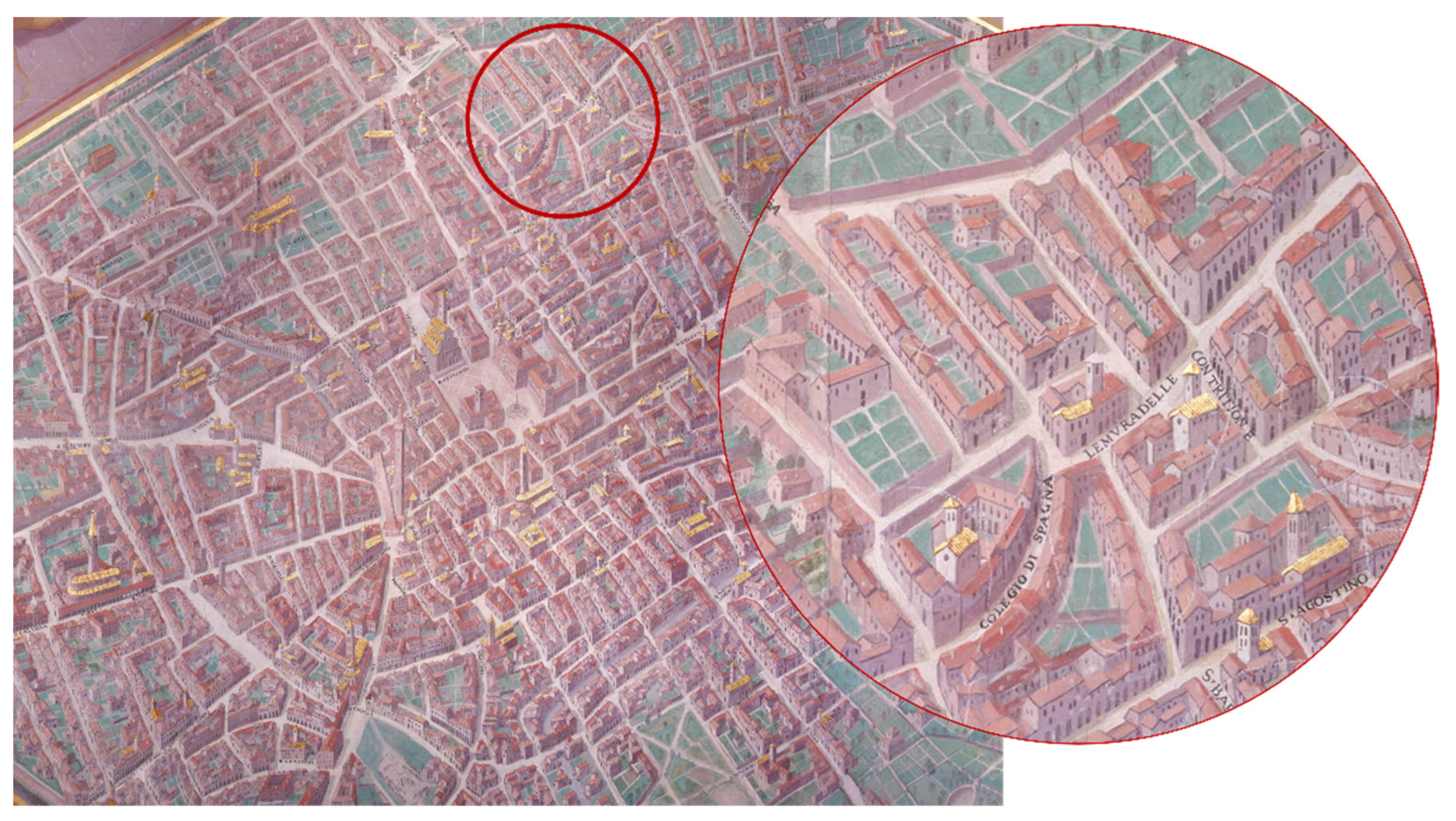

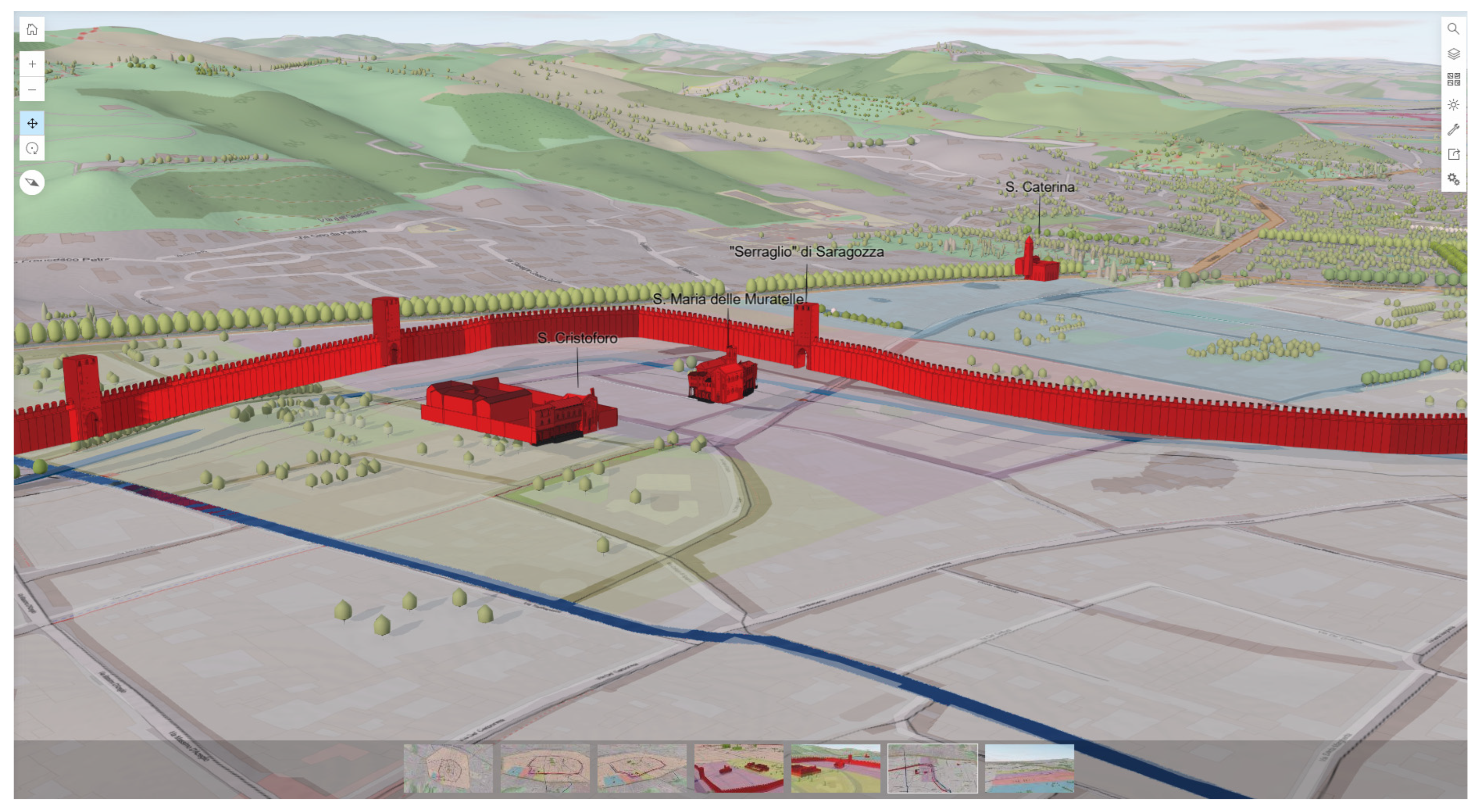
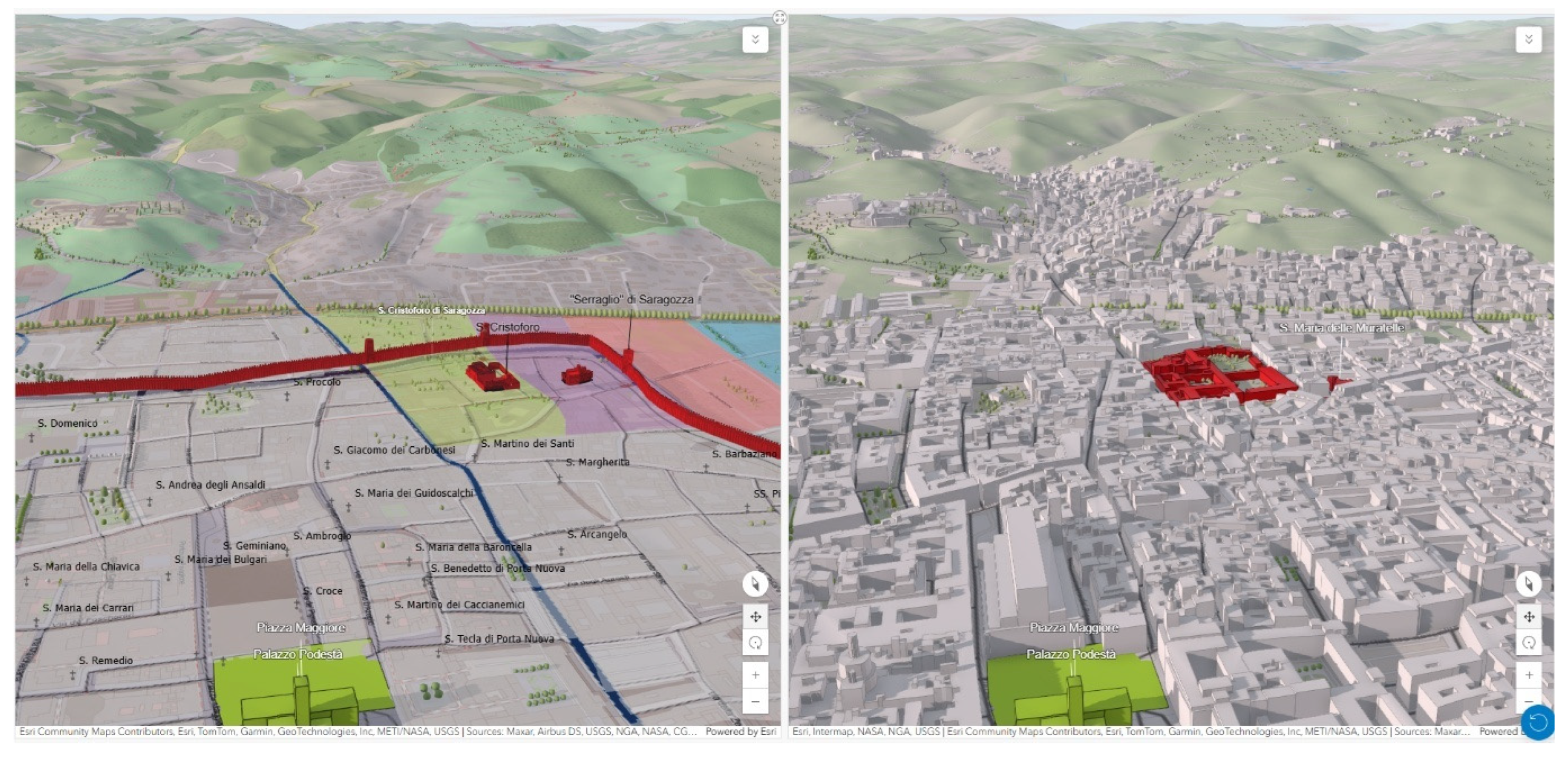

Disclaimer/Publisher’s Note: The statements, opinions and data contained in all publications are solely those of the individual author(s) and contributor(s) and not of MDPI and/or the editor(s). MDPI and/or the editor(s) disclaim responsibility for any injury to people or property resulting from any ideas, methods, instructions or products referred to in the content. |
© 2025 by the authors. Licensee MDPI, Basel, Switzerland. This article is an open access article distributed under the terms and conditions of the Creative Commons Attribution (CC BY) license (https://creativecommons.org/licenses/by/4.0/).
Share and Cite
Orlandi, M.; Smurra, R. Digital Humanities for the Heritage of Political Ideas in Medieval Bologna. Heritage 2025, 8, 239. https://doi.org/10.3390/heritage8070239
Orlandi M, Smurra R. Digital Humanities for the Heritage of Political Ideas in Medieval Bologna. Heritage. 2025; 8(7):239. https://doi.org/10.3390/heritage8070239
Chicago/Turabian StyleOrlandi, Marco, and Rosa Smurra. 2025. "Digital Humanities for the Heritage of Political Ideas in Medieval Bologna" Heritage 8, no. 7: 239. https://doi.org/10.3390/heritage8070239
APA StyleOrlandi, M., & Smurra, R. (2025). Digital Humanities for the Heritage of Political Ideas in Medieval Bologna. Heritage, 8(7), 239. https://doi.org/10.3390/heritage8070239






